Evergreen tree acacia silver (mimosa)
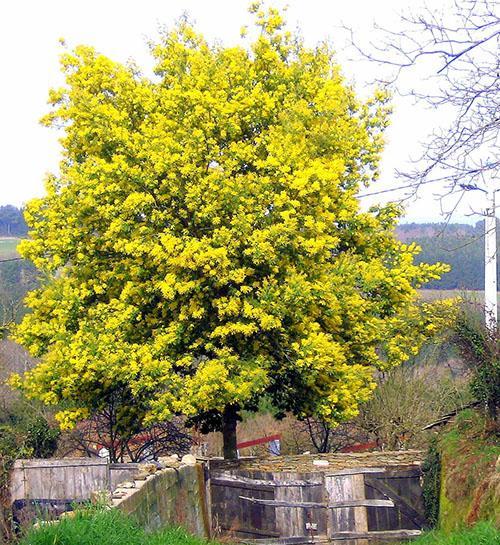 Each arrival of spring is associated with the scent of tulips and mimosa, the yellow branches of which hang down smoothly and delight with their rich color. Silver acacia - this is the name of the plant, which is popularly called mimosa. Home to the evergreen tree is the coast of Australia, but nowadays it has taken root well in southern Europe and Asia. This plant is very unpretentious and under suitable weather conditions can grow up to 20 meters. An interesting fact is that the silver acacia in the first year can reach a height of 1 meter, which allows it to be classified as a fast-growing species.
Each arrival of spring is associated with the scent of tulips and mimosa, the yellow branches of which hang down smoothly and delight with their rich color. Silver acacia - this is the name of the plant, which is popularly called mimosa. Home to the evergreen tree is the coast of Australia, but nowadays it has taken root well in southern Europe and Asia. This plant is very unpretentious and under suitable weather conditions can grow up to 20 meters. An interesting fact is that the silver acacia in the first year can reach a height of 1 meter, which allows it to be classified as a fast-growing species.
Mimosa - spring flower
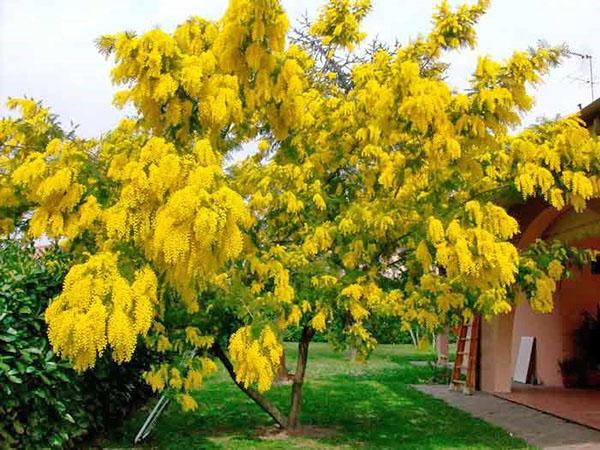 Despite the fact that acacia belongs to the legume family and grows to an impressive size, its flowers are always associated with the spring revival of nature. Acacia silver mimosa has a thorny trunk, leaves with a double dissection, which can be compared to a fern, and they are the background when drawing up bouquets. Yellow mimosa is distinguished by yellowish-gray flowers, which have a pleasant aroma and small size. Very often, flowers are collected in 20-30 pieces and make up spherical heads with a maximum diameter of 8 mm. Up to 90 such heads can be on one branch for a bouquet, and they attract attention with their constant size and doubleness.
Despite the fact that acacia belongs to the legume family and grows to an impressive size, its flowers are always associated with the spring revival of nature. Acacia silver mimosa has a thorny trunk, leaves with a double dissection, which can be compared to a fern, and they are the background when drawing up bouquets. Yellow mimosa is distinguished by yellowish-gray flowers, which have a pleasant aroma and small size. Very often, flowers are collected in 20-30 pieces and make up spherical heads with a maximum diameter of 8 mm. Up to 90 such heads can be on one branch for a bouquet, and they attract attention with their constant size and doubleness.
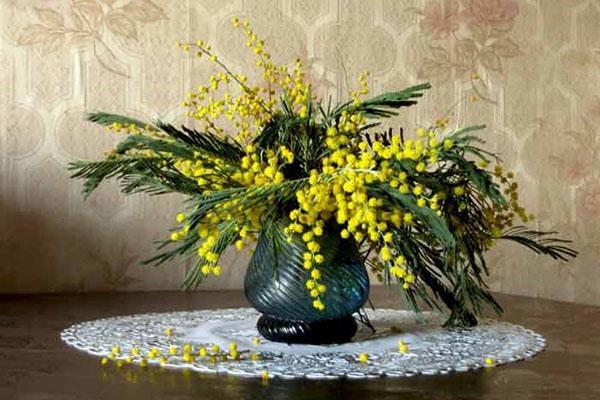 The spring flower is very common in the celebration of March 8 - it is at this time that the tree begins to bloom and decorate all streets and parks. Due to the fact that the tree is native to the Southern Hemisphere, the flowering period of acacia begins in early February and ends in April.
The spring flower is very common in the celebration of March 8 - it is at this time that the tree begins to bloom and decorate all streets and parks. Due to the fact that the tree is native to the Southern Hemisphere, the flowering period of acacia begins in early February and ends in April.
Mimosa is also an excellent honey plant - bees collect nectar from these flowers, which, when processed into honey, does not crystallize at all and remains the same liquid and very fragrant.
Silver acacia - features of growing at home
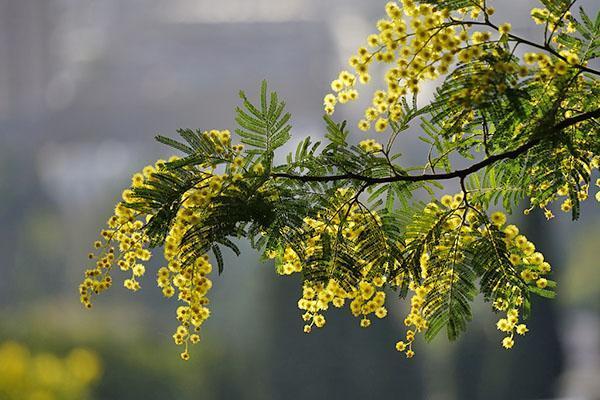 Despite the fact that this plant can grow to incredible heights, mimosa is a very popular houseplant. Many people use this tree in winter gardens and greenhouses, some are grown specifically for composing spring bouquets. Keeping mimosa indoors is not very difficult - for this it is only worth taking care of the light and watering the plant regularly.
Despite the fact that this plant can grow to incredible heights, mimosa is a very popular houseplant. Many people use this tree in winter gardens and greenhouses, some are grown specifically for composing spring bouquets. Keeping mimosa indoors is not very difficult - for this it is only worth taking care of the light and watering the plant regularly.
Silver acacia grows very well in soil with neutral acidity, and the soil must be crumbly and not dense.
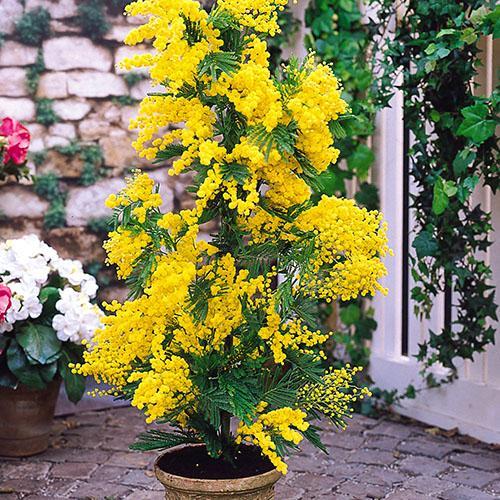 For mimosa, it is better to choose a place near the window - sunny, but without the presence of drafts. Even though this plant is drought-resistant, in the very first year it should to water as often as possible. And with the onset of cold weather, from about November to January, watering should be minimized. You can fertilize mimosa during spring and summer - it responds well to universal liquid fertilizers, but in the cold season it should be allowed to rest.
For mimosa, it is better to choose a place near the window - sunny, but without the presence of drafts. Even though this plant is drought-resistant, in the very first year it should to water as often as possible. And with the onset of cold weather, from about November to January, watering should be minimized. You can fertilize mimosa during spring and summer - it responds well to universal liquid fertilizers, but in the cold season it should be allowed to rest.
Mimosa - growing by seeds
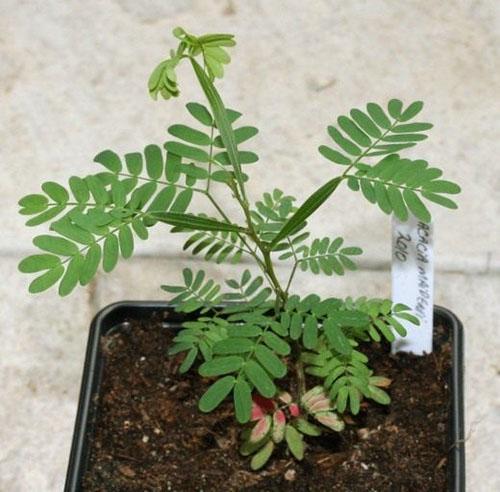 Silver acacia seeds are beans that begin to grow very quickly if all planting conditions are observed:
Silver acacia seeds are beans that begin to grow very quickly if all planting conditions are observed:
- Prepare a soil consisting of sand and humus-peat mixture
- Spread the seeds in a small amount on the surface of the ground, pressing slightly with your fingers
- Then you should resort to one very useful trick: pour the seeds with almost boiling water. Not with boiling water, but the water temperature should be about 85 degrees.
- The hot water should be easily absorbed into the ground, and you will hear a slight crackle of the seeds.
- Close the box with glass and wait for germination, which will not keep you waiting long.
If you followed the rules, you will get a young shoot in a couple of weeks.
Silver acacia blooms - video
Maybe someone can tell you when it is best to cut the branches of this mimosa? It grows on my balcony (and for the winter I will transfer it to a room), and it grows very quickly, and I have nowhere to transplant a large tree.
Thanks in advance for your reply
Tatyana
Silver acacia grows really willingly and quickly and therefore needs pruning, especially if it is indoor. It is recommended to carry out the procedure after flowering. First of all, you need to thin out the crown by cutting out thickening shoots, and also remove weak branches. In adult specimens, old branches are shortened by almost half, and young ones - by 1/3.